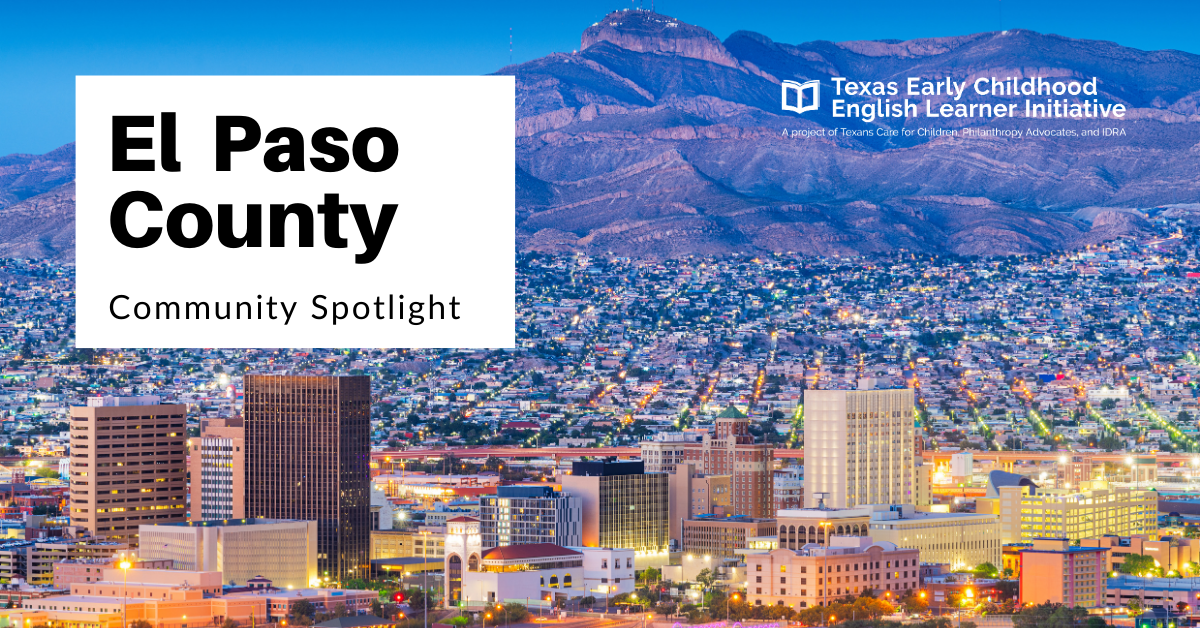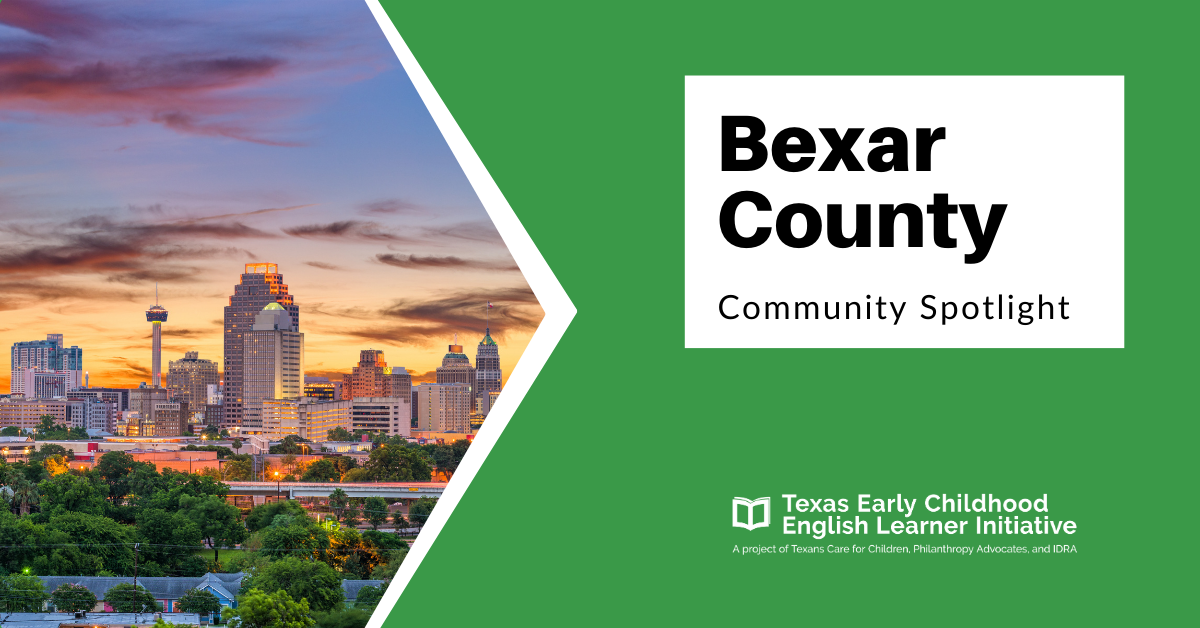El Paso County Spotlight
In El Paso, bilingualism is woven into the fabric of the community, where the lines between English and Spanish are intertwined. In border communities like El Paso, some families commute across the border daily for work and school. Community leaders shared how “translanguaging”, or speech that combines words and idioms from both Spanish and English, is commonplace, including in educational spaces. This supports a culture of bilingualism, where speaking in either language or a blend of both supports students’ learning in school and in social interactions.
Major school districts in the area have combined the community's strong bilingual culture with an emphasis on bilingual instruction in the classroom from early childhood through 12th grade. While there is still a growing need for quality bilingual education teachers, districts report that they are able to hire bilingual teachers from the local community, a positive reflection of “grow-your-own” teacher training efforts, such as through the University of Texas at El Paso’s partnership with local school districts. Local leaders note that celebrating and honoring children’s bilingual potential are critical components to providing a quality education. This is a particularly important part of local districts' approach to early childhood since English Learners account for nearly half of students in pre-k through third grade in the region.
By the Numbers
-
Percent of Pre-k-3rd Grade Students designated as ELs:
El Paso County: 38%
El Paso ISD: 38%
Socorro ISD: 34%
Ysleta ISD: 36%
Statewide: 27%Limited English Speaking Households and Language:
El Paso County: 24.23%
Statewide: 7.44% -
ISD Bilingual/ESL Programs:
El Paso ISD: Dual Language one-way and two-way, ESL
Socorro ISD: Transitional early exit, ESL
Ysleta ISD: Dual Language one-way and two-way, ESLAverage Pre-k Class Size:
El Paso ISD: 18
Socorro ISD: 23
Ysleta ISD: 24Percent of 4-year olds in Full-day Pre-K (18-19)*:
El Paso ISD : 0%
Socorro ISD: 59.81%
Ysleta ISD: 86.31%
Statewide: 60%*HB 3 required districts offer full-day pre-k to eligible 4-year olds, with available waivers, beginning in the 19-20 school year
-
Provider breakdown:
TRS Providers: 75
Non-TRS Providers: 128
Providers: 203
Percent TRS: 36.9%Statewide:
TRS Providers: 2,059
Non-TRS PRoviders; 5,131
Percent TRS: 28.6%Average children per day:
TRS Average: 2,400
Non-TRS Average: 1,761
Combined Average: 4,161
Percent TRS: 57.7%Statewide:
TRS Average: 56,318
Non-TRS Average: 78,678
Percent TRS: 41.7%
Local Successes and Models
We took a closer look at three local programs to better understand how the El Paso County community is addressing the education of English Learners (ELs)during the first eight years of childhood and to identify potential models for other areas of the state. We conducted a series of interviews with local leaders and gathered available regional data. We are grateful to leaders at El Paso ISD, Ysleta ISD, Paso del Norte, and the University of Texas El Paso for sharing their insights with us.
-
El Paso ISD has provided district-wide Dual Language Immersion (DLI) since 2014. All El Paso ISD pre-k classrooms for three-year-olds and most for four-year-olds are DLI . Within the DLI programs, El Paso ISD offers both one-way and two-way programs. The biggest difference in how they administer these programs is that they offer some two-teacher models in the two-way programs to educate both English learners and non-English learners. Using the 50-50 model, in which instruction is in English for half the day and in Spanish for half of the day, they are able to leverage the strengths of each educator, with one educator leading the English instruction while the other leads the Spanish instruction. Materials and curriculum are purchased in both languages.
District leaders are proud of their equity-driven dual language program, believing strongly in the bilingual curriculum and how it connects pre-k through high school. They cite an upward trend in closing the gap between in state assessment scores, including literacy, for English Learners compared to non-English Learners.
-
Like El Paso ISD, Ysleta ISD is offering DLI from pre-k through 12th grade. District leaders also point to five campuses where children are learning a third language.
The District has leveraged the state’s 2019 initiative requiring educators attend reading academies to better train their educators and develop a group of twelve leaders that work out of the central office to conduct literacy training and emphasize district goals around biliteracy.
The District also recently launched Encore 2025, which establishes several new goals for the district over the next five years. Within that strategy are measurable targets around how to improve the District’s dual language program by providing more research-based support and training to educators, increasing the number of EL students who meet grade level on reading and language arts assessments, and increasing the number of EL students making progress towards English proficiency.
-
Enrolling children as young as six weeks and as old as twelve years, PDN Children’s serves as a statewide example of providing a quality bilingual education in a nonprofit early care and education setting. They have received accreditation from the National Association for the Education of Young Children (NAEYC) every year since 2004.
Children enrolled at PDN’s Children’s Inclusive Early Learning Center have an opportunity to simultaneously enroll in El Paso ISD and receive instruction from school district teachers who are certified in bilingual education and special education. The partnership between PDN Children’s and the District offers a bilingual education model that alternates between English learning days and Spanish learning days.
As an inclusive early learning center, PDN Children’s emphasizes the needs of children with disabilities and developmental delays. For example, the Center prioritizes speech therapy, understanding that for children to become bilingual or even verbal, they must first address speech disabilities or delays. Through emphasizing family engagement and meeting all of the children’s individual needs, PDN Children’s demonstrates how an inclusive early learning center can give children a strong start at a bilingual education, as early as infancy.
“We’re looking at a real change in the way we look at identity, the way we look at the people that live here in this region, where we live and breathe through two cultures, through two languages. That is what bilinguals do!”
— Dr. Elena Izquierdo, University of Texas El Paso



